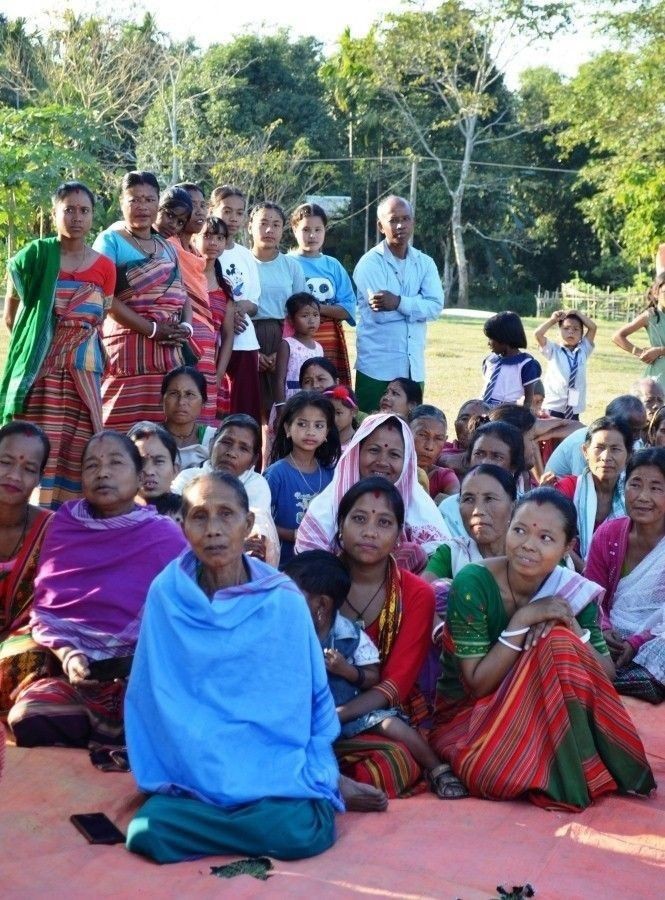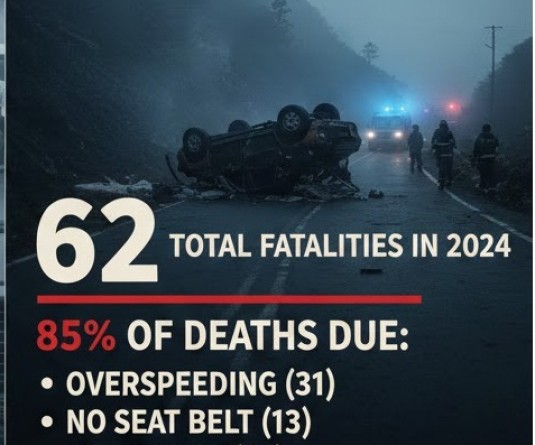Locals of Ajarbari village attend a public meeting. Ajarbari is one of the worst flood hit villages under Dhemaji district in Assam. (Morung Photo)

Ajarbari in Assam an example of how communities are coping with frequent floods
Akangjungla
Ajarbari (Dhemaji) | January 8
“People who are most affected during flooding are the women, children and people with disability. In 2014, before the raised platforms were introduced we had to go to the embankment,” a middle-aged woman in Ajarbari village said.
“The embankments are crowded, with very limited space. At that congested situation pregnant women, lactating mothers and children have to experience the worst,” she said.
Ajarbari is one of the worst flood hit villages located in Dhemaji district, Assam. The village has six wards with around 480 population.
“During rainy season the village is under water for six months,” Paramanda Pegu, President, Muktiyaar Gram Panchayat told The Morung Express.
Flooding concerns
Each year Assam witnesses frequent floods involving loss of life and huge economic costs, and relief camps spring up to house a large number of families for extended periods of time until the water recedes. The Brahmaputra River and its tributaries (Siang, Jiadhal, etc) become more volatile as rainfall patterns change; with tributaries changing their course and character (Jiadhal River has changed its course four times in the past five years.)
According to a first-of-its-kind Climate Vulnerability Index released by the Council on Energy, Environment and Water on October 26, 2021, ‘the states of Assam, Andhra Pradesh, Maharashtra, Karnataka and Bihar are most vulnerable to extreme climate events such as floods, droughts and cyclones in India.’
Amongst the top 20 most vulnerable districts of India, Dhemaji in Assam tops the list. Most villages in Dhemaji are located along the river. In 2022 alone over 100,000 people living in the district were affected by the floods.
The climate vulnerability in Dhemaji has revolved around flood. The district experiences a much unparalleled pattern of flooding. The flood is not uniform making it difficult for the communities to adapt. Some of the contributing factors are its unique geography surrounded by hills of Arunachal Pradesh, frequent flash floods of short duration, sand casting, meandering nature of river and erosion and small chaporis (low-lying flood-prone riverbanks) and hard to reach areas.
Livelihood under threat
According to Luit Goswami, Director of Rural Volunteers Centre (RVC) a total of 26 tributaries originating from Arunachal Pradesh passes through Dhemaji. RVC studies the impact of floods on local communities and aims at building community resilience in the flood-prone area of Dhemaji. Their interventions also cover areas in Lakhimpur, Majuli District, Biswanath and Sonitpur District of Assam.
“This year (2022) flooding started by April and continued till September. The area has received 63% more rainfall this season,” Luit said.
For the flood-hit villages, ‘displacement, migration and settlement in forest’ are common options when it comes to finding shelter. “Conflict between the host and settlers is unavoidable but what is inevitable is that in the course, the basic amenities are affected. The main problem is water and sanitation,” he observed.
Community resilience
“The village is located very close to the Brahmaputra River which makes it highly vulnerable to extreme floods. But people have learnt to live with floods,” Lal Bahadur Shitri, Secretary of Muktiyaar GP said.
The Ajarbari villagers have integrated indigenous practice and traditional knowledge to flood mitigation and management. As a community they have adopted the safe zones advocacy which includes high raised house constructions, taking shelter in raised platforms, safe migration practices, new system of agriculture and Risk Informed Panchayat.
“Communities are prepared,” Goswami said.
“From 1988 onwards the flood devastation has became more intensified, but within that the community is still doing their best to survive. Somehow they are managing. In due course of time, new things have emerged. Government is also doing new things. We have active Panchayats and gradually convergences have taken place,” he added.
Raised Platforms
Ajarbari village has also adopted raised platforms, a structure which is constructed on the highest point of the flood-affected area to enable people to take shelter during floods. The structure is used for public utility during the dry season.
The raised platforms are higher than the highest point of the last flood. The construction is done under the MNREGA which directly supports the livelihood of the villagers.
In 2014, the Mising Autonomous Council constructed the raised platform. In 2016, RVC raised it 2-feet higher. The Panchayat collaborated to construct raised hand pump and toilets.
During the flooding season, the Village Health and Nutrition Day do not get affected. The Gaon Panchayat in convergence with RVC, UNICEF and Assam government implement risk-adapted programmes. With the active involvement of local youths and women, health, nutrition, education and safety concerns of children and women are taken care of during the disaster period.
“We gather the children and bring them to the raised platforms by boat,” Netul Hojang, a member of the AKK Young Star Youth Club, Ajarbari said. “The space is small so we have to be very creative to keep the children protected and happy.”
Junali Hazong (41), an Anganwadi worker at Ajarbari Anganwadi Centre shares that despite the hardship of space congestion and distance, the community health workers of the area come together to ensure that there is no disruptions in delivering health services.
Safe coping practice
According to Luit, the Ajarbari Village Disaster Management Committee, which he calls a “People’s Institution” plays key role. The villagers have formed a system where annually each household contributes to a contingency fund. ‘During disasters, if a house is washed away they can support that family from the fund,’ he added.
“Another best thing on their part is, if we provide yarn to 50 women, after weaving and producing something, they give back the seed amount to the Committee which is again invested to support more women,” Luit said.
Migration is common but it is seasonal, Luit remarked adding, “People who cannot take up any income generation activities go to other places, mostly Arunachal and Guwahati and some other cities, but they all come back to the village. People are not indulging in unsafe migration.”
Instead of giving up on agriculture, despite the loss caused by flooding, villagers are now cultivating rabi and cash crops like mustard, potato, green peas, and French beans. He said that these crops are less time-consuming and economically more viable.
“They want to build themselves with their own resources and with the old traditional skills. That is how the community is organised,” he asserted while adding, “Taking ownership is the main key to adapting to disaster management… Resilience building system within the committee has grown.”






